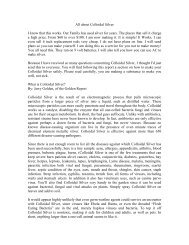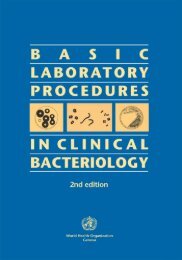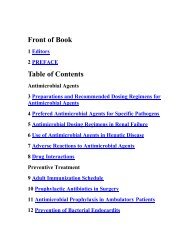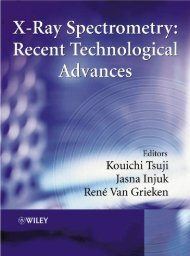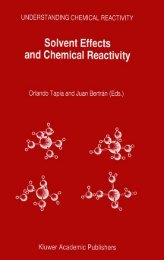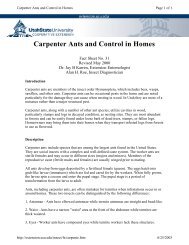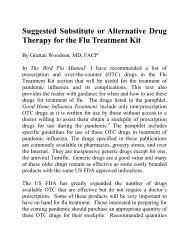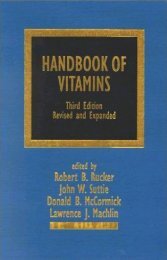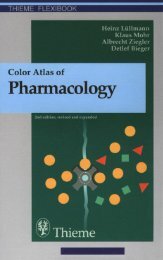The Nutritional Biochemistry of Chromium(III) - Survival-training.info
The Nutritional Biochemistry of Chromium(III) - Survival-training.info
The Nutritional Biochemistry of Chromium(III) - Survival-training.info
Create successful ePaper yourself
Turn your PDF publications into a flip-book with our unique Google optimized e-Paper software.
Introduction: A history <strong>of</strong> chromium studies (1955–1995) 19and LDL levels differed significantly between the subjects started on the supplement andthe group started on the placebo, with those on the placebo having lower initial values.Another well-performed study <strong>of</strong> interest was performed using hypoglycemic subjectsby Anderson, et al. [143] Eight female subjects were given 200 g Cr/day asCrCl 3 for 12 weeks. No change was observed in total cholesterol, HDL, LDL, VLDL,or triglyceride levels. <strong>The</strong> area <strong>of</strong> glucose below the fasting glucose level in glucosetolerance tests was lowered after 6 weeks <strong>of</strong> supplementation but was not significantlychanged after 12 weeks.<strong>The</strong> consensus <strong>of</strong> these studies is that Cr supplementation <strong>of</strong> healthy adults hasno effect on glucose, insulin, or blood lipids, while it is possible that subjects withmarginally abnormal blood glucose levels after a glucose challenge may be affectedbeneficially by supplementation.Perhaps the strongest evidence for an essential role <strong>of</strong> chromium in humans arisesfrom studies <strong>of</strong> patients on total parenteral nutrition (TPN) [115, 144]. Patients on TPNhave developed impaired glucose utilization [145] or glucose intolerance and neuropathyor encephalopathy [146–148]. <strong>The</strong> symptoms were reversed by chromium infusionand not other treatments. While limited to five individual cases, these studies provideevidence <strong>of</strong> clinical symptoms associated with Cr deficiency that can be reversed by supplementation.Another patient on TPN who developed symptoms <strong>of</strong> adult-onset diabetesand hyperlipidemia but died had low tissue Cr levels [149]. Curiously, the development<strong>of</strong> symptoms which were reversible by Cr supplementation does not correlate with serumCr levels [115], indicating that serum Cr levels are not an indicator <strong>of</strong> Cr deficiency.<strong>The</strong>se incidences have recently been reviewed [115, 150]. Additionally, these incidences<strong>of</strong> diagnosed potential Cr deficiency have been questioned recently as they lack consistentrelationships between the Cr in the TPN, time on TPN before symptoms, serum Crlevels, and symptoms [151]. Hence, no known indicator <strong>of</strong> Cr deficiency exists otherthan reversal <strong>of</strong> symptoms upon Cr supplementation [115]; a marker for Cr status intissues is desperately needed.Additional evidence for a potential role for Cr comes from studies <strong>of</strong> Cr absorptionas a function <strong>of</strong> chromium intake. Absorption varies inversely with intake as low intakes(∼15 g/day) lead to high rates <strong>of</strong> absorption (∼2%) while high intake (∼35 g/day)reduces absorption to ∼0.4% [152]. Work from the same research group indicates thatabsorption <strong>of</strong> Cr may not be inversely proportional to intake in rats [153].A role for Cr in the body is also suggested by an association between insulinaction and increased urinary loss, although other explanations may be possible. Inhuman euglycemic hyperinsulinemic clamp studies, Morris and coworkers have shownthat increases in blood insulin concentrations following an oral glucose load result insignificant decreases in plasma chromium levels; a subsequent infusion <strong>of</strong> insulin led t<strong>of</strong>urther chromium losses [154]. Within one-and-a-half hours after the increases <strong>of</strong> bloodinsulin concentrations, blood chromium levels started to recover. Patients also showedincreased urinary chromium losses during the course <strong>of</strong> the experiments, with the amount<strong>of</strong> chromium lost roughly corresponding to the amount <strong>of</strong> chromium estimated to be lostfrom the intravascular space [154]. Studies with human and rat tissue have demonstratedthat chromium binding by insulin-dependent tissues is significantly enhanced by glucose,suggesting that chromium may translocate from the blood compartment to insulinsensitivetissues [155]. (However, these studies used CrCl 3 as the chromium source; the



